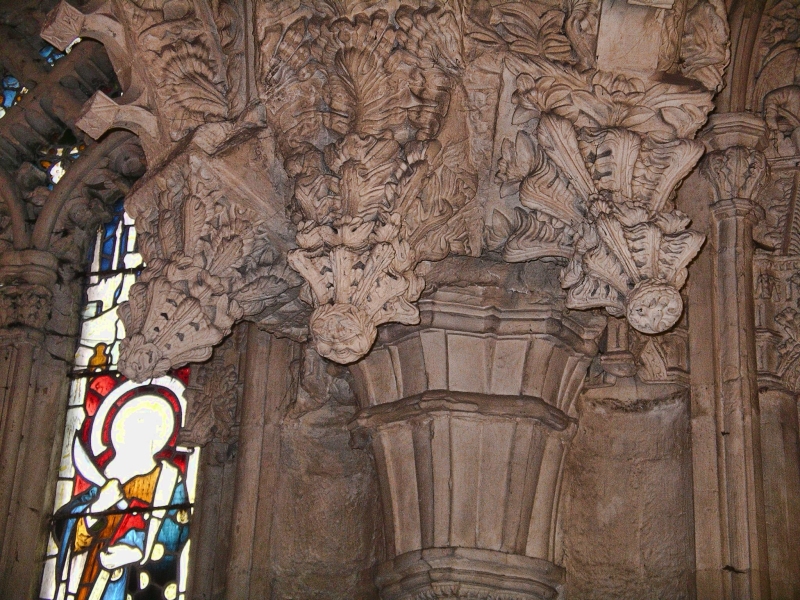
The roads do seem to be better marked in Scotland (for the moment) and before long we've arrived at Rosslyn Chapel. Located on the edge of a steep wooded valley, it's difficult to believe the chapel is only six miles from the hustle and bustle of Edinburgh.
Shrouded in netting and surrounded by skeletal scaffolding, the exterior is looking more than a little bleak on this gray misty day. The interior more than makes up for it. Everywhere we look there are amazing carvings.
Built in 1446 by William St. Clair, third and last Prince of Orkney, Rosslyn Chapel is rich in ornamentation which seems endless in variety. It's astounding the amount of work that went into this place. The pillars, the ceiling, the arches – nothing is left undecorated. I am rendered speechless with awe. Dragons, angels, knights, flowers, stars – they're all magnificent.
Many of the Biblical stories are portrayed and there are references to the Knights Templar. Pagan symbols can be found here too. Rosslyn has the largest number of "Green Men" found in any Medieval building.
Marvelous stained glass windows, brightly colored and well preserved, light the chapel in a warm rainbow. I am surrounded by things that I love, the things that have defined my love of this land for so many years and can barely believe my eyes. Rosslyn really can't be described – it must be experienced.
Dana and I go in search of the carving of the death mask of Robert the Bruce, aided by a sign near the front of the Chapel. Counting windows and altars, we finally find it, tucked up at an angle, beneath and held by an angel. I turn and look for Robin, but she's nowhere to be seen. Soon she appears from below. Taking my arm she whispers "You have to go down there."
I hadn't yet found this quiet place in my wandering and head right down. It's so quiet, so hushed and I am reminded of the Saxon crypt at Ripon. There is a tombstone here inscribed "William De St. Clair, Knight Templar." This part of Rosslyn is modest compared to the wonders of above, but no less special.
In the gift shop I buy a handful of post cards picturing some of the more elaborate carvings. I also purchase a book entitled Scotland's Stained Glass. Thus begins a book buying spree that lasts several days.
Three o'clock seems to be the time that our stomachs start making their rumbling announcement that yes, breakfast was good, but have you looked at your watch lately? After a quick stop at a grocery store in town for a snack of a scone and a Pepsi, we're off on our way to Crichton Castle.

Rosslyn Chapel was founded on a small hill above Roslin Glen as a Catholic collegiate church in the mid-15th century. The chapel was founded by William Sinclair, 1st Earl of Caithness.
Construction of the chapel began on 20 September 1456, although it has often been recorded as 1446. The confusion over the building date comes from the chapel's receiving its founding charter to build a collegiate chapel in 1446 from Rome. Sinclair did not start to build the chapel until he had built houses for his craftsmen.
After the Scottish Reformation (1560), Catholic worship in the chapel was brought to an end. The Sinclair family continued to be Catholics until the early 18th century.
One of the more notable architectural features of the Chapel is the "Apprentice Pillar, or "Prentice Pillar". Originally called the "Prince's Pillar" (in the 1778 document An Account of the Chapel of Roslin) the name morphed over time due to a legend dating from the 18th century, involving the master mason in charge of the stonework in the chapel and his young apprentice mason. According to the legend, the master mason did not believe that the apprentice could perform the complicated task of carving the column without seeing the original which formed the inspiration for the design.
Read more about Rosslyn Chapel at Wikipedia.